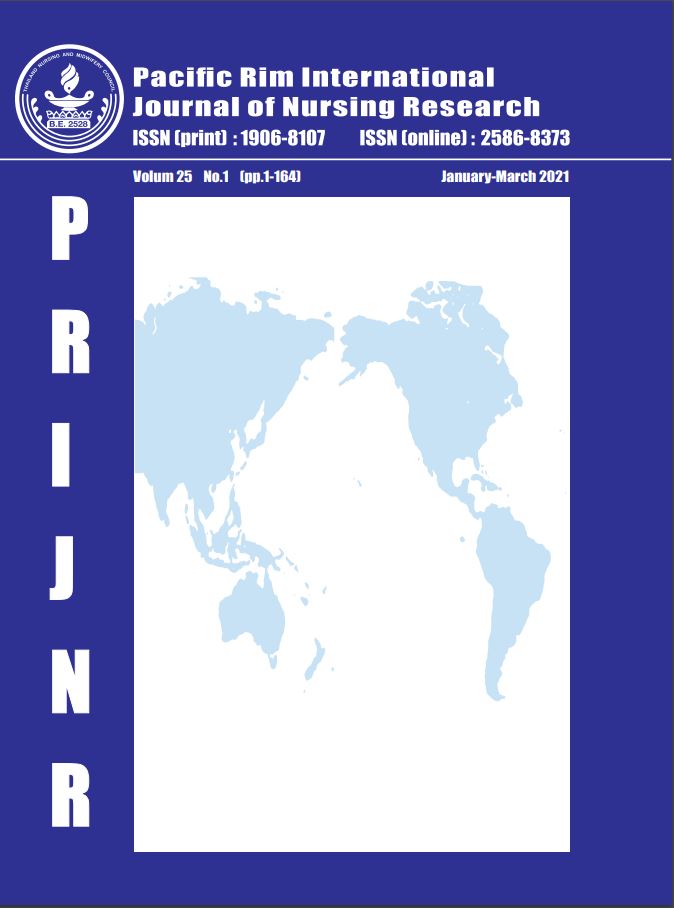Translation and Testing of the Verbal and Social Interaction for Nursing Students Questionnaire in Thailand
Keywords:
Communication, Education, Interpersonal interaction, Nursing students, Psychometric testing, Reliability, Thailand, Translation, ValidityAbstract
A measure to assess the verbal and social caring interactions, and communication skills of nursing students is important as a baseline in nursing education, but until this study, there was no instrument available in Thailand. We translated the revised Verbal and Social Interaction for Nursing Students questionnaire into Thai, using a back-translation method. Participants included 158 consenting senior nursing students at an Eastern Thailand university who were caring for people with psychiatric-mental health problems. Internal consistency reliability and construct validity were tested, using descriptive statistics, confirmatory factor analysis, correlation coefficients, and Cronbach’s alpha for internal reliability.
Results revealed that the Verbal and Social Interaction for Nursing Students (Thai) version was well-understood by the nursing students. The translated scale yielded acceptable reliability values ranging from 0.88-0.93. The measurement models were modified through modification indices and the final model fit the data, thus confirming construct validity. The translated scale was evidenced to be a valid and reliable instrument. Nurse educators in Thailand may use this scale to assess the competency of nursing students interacting with clients requiring not only psychiatric-mental health care but routine care as well. We recommend further testing of the scale with different groups of nursing students across Thailand.
References
Furnes M, Kvaal KS, Høye S. Communication in mental health nursing - Bachelor Students' appraisal of a blended learning training programme - an exploratory study. BMC Nurs. 2018; 17: 20. https://doi.org/10.1186/s12912-018-0288-9
Van der Elst E, Dieckx de Casterle B, Gastmans C. Elderly patients’ and residents’ perceptions of the good nurse: a literature review. J Med Ethics. 2012; 38(2): 93-7. https://doi.org/10.1136/medethics-2011-100046
Expósito JS, Costa CL, Agea JLD, Izquierdo MDC, Rodríguez DJ. Ensuring relational competency in critical care: Importance of nursing students' communication skills. Intensive Crit Care Nurs. 2018; 44: 85-91. https://doi. org/10.1016/j.iccn.2017.08.010
Li Y, Wang X, Zhu X-r, Zhu Y-r, Sun J. Effectiveness of problem-based learning on the professional communication competencies of nursing students and nurses: A systematic review. Nurse Educ Pract. 2019; 37: 45-55. https:// doi. org/10.1016/j.nepr.2019.04.015.
Ferrández-Antón T, Ferreira-Padilla G, del-Pino-Casado R, Ferrández-Antón P, Baleriola-Júlvez J, Martínez-Riera JR. Communication skills training in undergraduate nursing programs in Spain. Nurse Educ Pract. 2020; 42: 102653. https://doi.org/10.1016/j.nepr.2019.102653
Watt E, Pascoe E. An exploration of graduate nurses’ perceptions of their preparedness for practice after undertaking the final year of their Bachelor of Nursing degree in a university-based clinical school of nursing. Int J Nurs Pract. 2013; 19: 20-30. https://doi.org/10.1111/ijn.12032
Bisholt BKM. The professional socialization of recently graduated nurses-experiences of an introduction program. Nurse Educ Today. 2012; 32(3): 278-82. https://doi: 10.1016/j.nedt.2011.04.001
Kaihlanena AM, Salminena L, Flinkmana M, Haavistoa E. Newly graduated nurses’ perceptions of a final clinical practicum facilitating transition: a qualitative descriptive study. Collegian. 2019; 26: 55-61. https://doi.org/10.1016/ j.colegn.2018.03.003
Duchscher JB, Windey M. Stages of transition and transition shock. J Nurse Prof Dev. 2018; 34(4): 228-32. doi: 10.1097/NND.0000000000000461
Edwards D, Hawker C, Carrier J, Rees C. A systematic review of the effectiveness of strategies and interventions to improve the transition from student to newly qualified nurse. Int J Nurs Stud. 2015; 52(7): 1254–68. https://doi.org/ 10.1016/j.ijnurstu.2015.03.007
Phillips C, Kenny A, Esterman A, Smith C. A secondary data analysis examining the needs of graduate nurses in their transition to a new role. Nurs Educ Pract. 2014; 14(2): 106–11. doi: 10.1016/j.nepr.2013.07.007
de Araujo Sartorio N, Pavone Zoboli EL. Images of a ‘good nurse’ presented by teaching staff. Nurs Ethics. 2010; 17: 687-94. http://doi.org/10.1177/09697330103 78930
Rask M, Brunt D. Verbal and social interactions in the nurse-patient relationship in forensic psychiatric nursing care-a model and its philosophical and theoretical foundation. Nurs Inq. 2007; 14: 169-76. https://doi. org/10.1111/j.1440-1800.2007-00364.x
Brunt D, Rask M. Validation of the verbal and social interaction questionnaire: carers’ focus in the carer-resident relationship in supported housing facilities for persons with psychiatric disabilities (VSI-SH). J Psychiatr Ment Hlt Nurs. 2013; 20: 279-85. https://doi.org/10.1111/ j.1365-2850.2012.01925.x
Rask M, Gunilla A, Jalal S, Stig W, Lisbet A, Monica CB, Lise-Lotte O, Cristel B, Gunilla L. (2018). Validation of the verbal and social interaction questionnaire for nursing students-the focus of nursing students in their relationship with patients. J Nurs Educ Pract. 2018; 8(4): 81-8. https://doi.org/10.5430/jnep.v8n4p81
Beaton D, Bombardier C, Guillemin F, Ferraz MB. Recommendations for the cross-cultural adaptation of the DASH & QuickDASH outcome measures. Institute for Work and Health, Toronto, Canada; 2007 June [cited 2020, February 28]. 45 p. Available from: http://www.dash.iwh.on.ca/ sites/dash/ files/downloads/cross_cultural_adaptation_ 2007.pdf
Tyupa S. A theoretical framework for back-translation as a quality assessment tool. New Voices Transl Stud. 2011; 7: 35-46.
Kyriazos AT. Applied psychometrics: sample size and sample power consideration in factor analysis (EFA, CFA) and SEM in general. Psychology. 2018; 9: 2207-30. doi:10.4236/psych.2018.98126.
Brown TA. Confirmatory factor analysis for applied research. 2nd ed. New York: The Guilford Press; 2015. 462 p.
Hair JF, Black WC, Babin BJ, Anderson RE. Multivariate data analysis. 7th ed. (Pearson New International Edition). Edinburg, England: Pearson Education; 2014. 734 p.
Waltz CF, Strickland OL, Lenz ER. Measurement in nursing research. 5th ed. New York: Springer; 2017. 612 p.
Pitakchinnapong N, Rhein D. Exploration of the causation of stigmatization of mental illness in Thailand: perceptions of Thai university students. Human Behavior, Development and Society. 2019; 20(2): 7-19.
Wolff AC, Pesut B, Regan S. New graduate nurse practice readiness: perspectives on the context shaping our understanding and expectation. Nurs Educ Today. 2010; 30: 187-91. https://doi.org/10.1016/j.nedt.2009.07.011
Hustad J, Johannesen B, Fossum M, Hovland OJ. Nursing students’ transfer of learning outcomes from simulationbased training to clinical practice: a focus-group study. BMC Nurs. 2019; 18: 53. https://doi.org/10.1186/ s12912-019-0376-5
Downloads
Published
How to Cite
Issue
Section
License
Copyright: The Pacific Rim International Journal of Nursing Research, Thailand Nursing & Midwifery Council has exclusive rights to publish, reproduce and distribute the manuscript and all contents therein.








.png)



